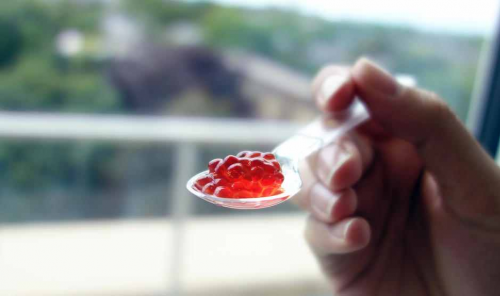Cambridge-Based Company Invents First Ever 3D Fruit Printer
A company in Cambridge called Dovetailed has figured out a way to create edible and nutritious "fruit" using a special 3D printer they invented.
Before you start getting excited about the possibility of printing out unlimited strawberries and bananas from your office desk, we should probably specify that the printed product is not in the shape or form of an actual fruit.
Instead, the machine takes fruit juices and uses a special process to turn them into gelatinous globs that resemble tapioca pearls or caviar.
When you bite into the printed fruit globules they burst open in your mouth and release their delicious juice, much like a real fruit. With that said, Dovetail's machine could more accurately be referred to as a fruit snack printer.
How Does It Work?
The new fruit printing machine is able to wrap fruit juice in a gelatinous coating using a special molecular gastronomy technique known as spherification.
In more basic terms, the fruit juice is mixed with alginic acid and then that solution is slowly dripped into a bath of calcium chloride.
When the juice/acid mix hits the calcium chloride a chemical reaction occurs that creates a thin skin around the fruit juice - kind of like the skin of a blackberry, but not as thick.
The end result is a juicy, succulent fruit snack that (depending on the quality of juice used) is as close to real fruit as any machine can produce.
Is 3D Printed Food the Future of Home Economics and Space Travel?
This isn't the first time a company or organization has successfully used 3D printing technology to create viable food. Another company called Natural Machines came up with a way to print out pizza using a printer loaded with fresh ingredients.
On the same note, NASA gave a $125,000 grant to Systems and Materials Research out of Austin, Texas to fund the organizations attempt at creating a 3D food printing machine that could reliably and affordably make pizzas for astronauts on space journeys.
Of course, with chocolate being such a popular favorite on all occasions, it isn't surprising that two companies - KS Design Lab and FabCafe - held a workshop in Tokyo to demonstrate their ability to scan life-size objects (i.e. - humans) and print out chocolate replicas of them using a 3D chocolate printer.
So what does all this mean for the future of culinary arts then? While technology is certainly advancing enough to make robotic chefs a possibility, it is unlikely that machines will ever fully replace the role of the human chef.
Instead, food printing machines will probably be used to assist chefs in the preparation and presentation processes.
Imagine if instead of ordering cake decorations and confections from the local bakery you could create them at home to your own specifications. Want a healthy snack to feed your kids? Pour some good fruit juice into the fruit snack printer and serve when ready!

